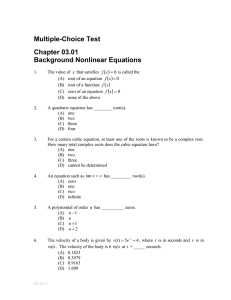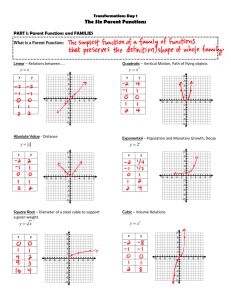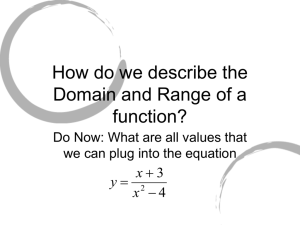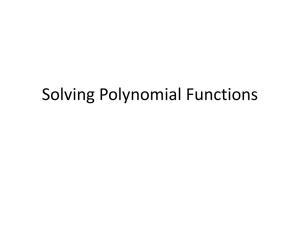Constructing and Counting Number Fields
advertisement
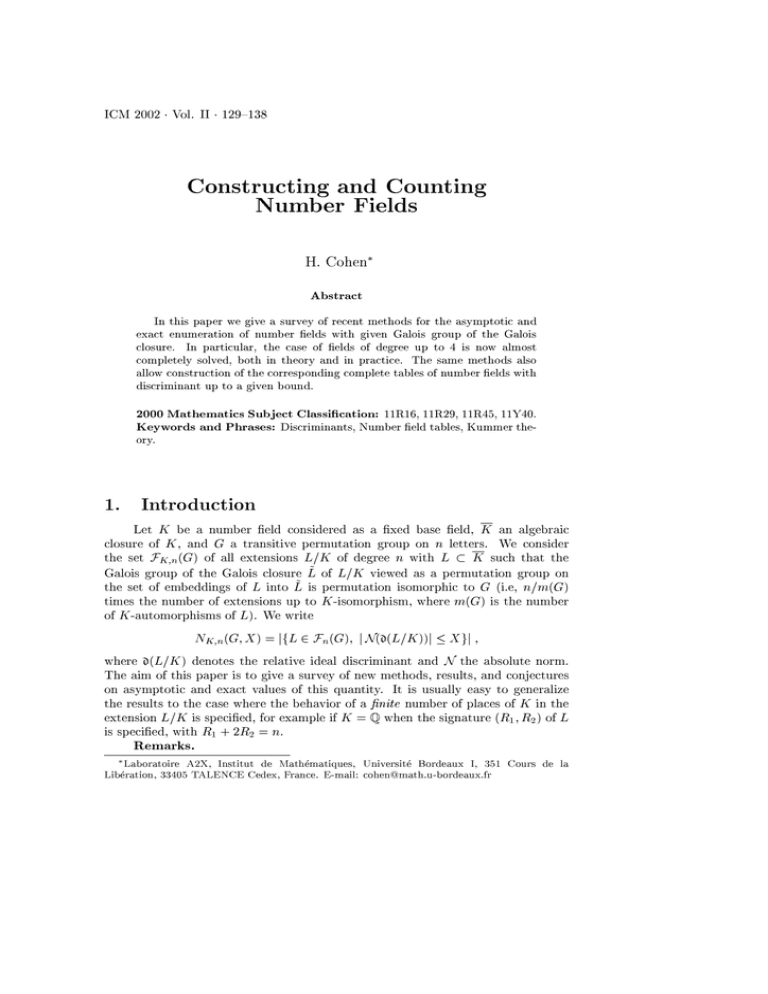
ICM 2002 • Vol. II • 129^138
Constructing and Counting
Number Fields
H. Cohen*
Abstract
In this paper we give a survey of recent methods for the asymptotic and
exact enumeration of number fields with given Galois group of the Galois
closure. In particular, the case of fields of degree up to 4 is now almost
completely solved, both in theory and in practice. The same methods also
allow construction of the corresponding complete tables of number fields with
discriminant up to a given bound.
2000 Mathematics Subject Classification: 11R16, 11R29, 11R45, 11Y40.
Keywords and P h r a s e s : Discriminants, Number field tables, Kummer theory.
1.
Introduction
Let K be a number field considered as a fixed base field, K an algebraic
closure of K, and G a transitive permutation group on n letters. We consider
the set TK,U(G)
of all extensions L/K of degree n with F c K such t h a t the
Galois group of the Galois closure L of L/K viewed as a permutation group on
the set of embeddings of F into L is permutation isomorphic t o G (i.e,
n/m(G)
times the number of extensions up t o FJ-isomorphism, where m(G) is the number
of K-automorphisms
of F ) . We write
NK,n(G,X)
= \{L £ Tn(G),
\N[v(L/K))\
< X}\ ,
where Q(L/K) denotes the relative ideal discriminant and TV the absolute norm.
T h e aim of this paper is t o give a survey of new methods, results, and conjectures
on asymptotic and exact values of this quantity. It is usually easy t o generalize
the results t o the case where the behavior of a finite number of places of K in the
extension L/K is specified, for example if K = Q when the signature ( F i , R2) of F
is specified, with F i + 2 F 2 = n.
Remarks.
* Laboratoire A2X, Institut de Mathématiques, Université Bordeaux I, 351 Cours de la
Libération, 33405 TALENCE Cedex, France. E-mail: cohen@math.u-bordeaux.fr
130
H. Cohen
1. It is often possible to give additional main terms and rather good error terms
instead of asymptotic formulas. However, even in very simple cases such as
G = S3, this is not at all easy.
2. The methods which lead to exact values of NK,U(G,X)
always lead to algorithms for computing the corresponding tables, evidently only when
NK,U(G,X)
is not too large in comparison to computer memory, see for example [8] and [10].
General conjectures on the subject have been made by several authors, for
example in [3]. The most precise are due to G. Malle (see [24], [25]). We need the
following definition.
Definition 1.1. For any element g £ Sn different from the identity, define
the index 'md(g) of g by the formula 'md(g) = n — |orbits of g\. We define the index
i(G) of a transitive subgroup G of Sn by the formula
i(G) =
min
ind(p) .
Examples.
1. The index of a transposition is equal to 1, and this is the lowest possible index
for a nonidentity element. Thus i(Sn) = 1.
2. If G is an Abelian group, and if £ is the smallest prime divisor of \G\, then
i(G) =
\G\(l-l/t).
Conjecture 1.2. For each number field K and transitive group G onn letters
as above, there exist a strictly positive integer 1>K(G) and a strictly positive constant
CK(G) such that
NK,n(G,X)
~ cK(G)X1/i{G\\ogX)bK{G)-1
.
In [25], Malle gives a precise conjectural value for the constant bx(G) which
is too complicated to be given here.
Remarks.
1. This conjecture is completely out of reach since it implies the truth of the
inverse Galois problem for number fields.
2. If true, this conjecture implies that for any composite n, the proportion of
S^-extensions of K of degree n among all degree n extensions is strictly less
than 1 (but strictly positive), contrary to the case of polynomials.
The following results give support to the conjecture (see [2], [9], [18], [19], [20],
[21], [22], [23], [28], [30]).
Theorem 1.3. We will say that the above conjecture is true in the weak sense
if there exists CK (G) > 0 such that for all e > 0 we have
CK
(G)-X1^G)
< NK,n(G,X)
< A-V'CGH* .
1. (Moki, Wright). The conjecture is true for all Abelian groups G.
2. (Davenport-Heilbronn, Datskovsky-Wright). The conjecture is true for n = 3
and G = S3.
Constructing and Counting Number Fields
131
3. (Cohen-Diaz-Olivier). The conjecture is true for n = 4 and G = F 4 .
4- (Bhargava, Yukie). The conjecture is true for n = 4 and G = S 4 , in the weak
sense if K ^ Q.
5. (Klüners-Malle). The conjecture is true in the weak sense for all nilpotent
groups.
6. (Kable-Yukie). The conjecture is true in the weak sense for n = 5 and G = S5.
The methods used to prove these results are quite diverse. In the case of
Abelian groups G, one could think that class field theory gives all the answers so
nothing much would need to be done. This is not at all the case, and in fact Kummer
theory is usually more useful. In addition, Kummer theory allows us more generally
to study solvable groups. We will look at this method in detail.
Apart from Kummer theory and class field theory, the other methods have a
different origin and come from the classification of orders of degree n, interpreted
through suitable classes of forms. This can be done at a very clever but still elementary level when the base field is Q, and includes the remarkable achievement of
M. Bhargava in 2001 for quartic orders. Over arbitrary K, one needs to use and
develop the theory of prehomogeneous vector spaces, initiated at the end of the
1960's by Sato and Shintani (see for example [26] and [27]), and used since with
great success by Datskovsky-Wright, and more recently by Wright-Yukie (see [29]),
Yukie and Kable-Yukie.
2.
Kummer theory
This method applies only to Abelian, or more generally solvable extensions.
2.1.
W h y not class field theory?
It is first important to explain why class field theory, which is supposed to
be a complete theory of Abelian extensions, does not give an answer to counting
questions. Let us take the very simplest example of quadratic extensions, thus with
G = C 2 . A trivial class-field theoretic argument gives the exact formula
NK,2(C2,X) = -1+
J2
1MCl+AK))MK
(
X
where 0 runs over all integral ideals of K of norm less than or equal to X, Cl^(K)
denotes the narrow ray class group modulo 0, rk(G) denotes the 2-rank of an Abelian
group G, and MK(U) is the generalization to number fields of the summatory function M(n) of the Möbius function.
This formula is completely explicit, the quantities Cl^(K) and the function
Mic(n) are algorithmically computable with reasonable efficiency, so we can compute iVif j2 (C 2 ,X) for reasonably small values of X in this way. Unfortunately, this
formula has two important drawbacks.
The first and essential one is that, if we want to deduce from it asymptotic
information on NK,2(C2,X),
we need to control rk(Cl+(K), which can be done,
132
H. Cohen
although rather painfully, but we also need to control MK(U), which cannot be
done (recall for instance that the Riemann Hypothesis can be formulated in terms
of this function).
The second drawback is that, even for exact computation it is rather inefficient,
compared to the formula that we obtain from Kummer theory. Thus, even though
Kummer theory is used in a crucial way for the constructions needed in the proofs
of class field theory, it must not be discarded once this is done since the formula
that it gives are much more useful, at least in our context.
2.2.
Quadratic extensions
As an example, let us see how to treat quadratic extensions using Kummer
theory instead of class field theory. Of course in this case Kummer theory is trivial
since it tells us that quadratic extensions of K are parameterized by K*/K*" minus
the unit class. This is not explicit enough. By writing for any a £ K*, OLLK = nq2
with o an integral squarefree ideal, it is clear that K*/K*" is in one-to-one correspondence with pairs (o, «), where o are integral squarefree ideals whose ideal
class is a square, and u is an element of the so-called Selmer group of K, i.e., the
group of elements u £ K* such that UZK = q2 for some ideal q, divided by K**.
We can then introduce the Dirichlet series $if,2(C72)«) = ^ L jV'(()(F/Kj)^ s , where
the sum is over quadratic extensions L/K in K. A number of not completely trivial combinatorial and number-theoretic computations (see [9]) lead to the explicit
formula
<^2(C2,s) = ^l + —
£
W^L^x,,),
ÇK(2s) *-< M2/c)<
where \
x
runs over au
quadratic characters of the ray class group Clc2(K) and
is the ordinary Dirichlet-Hecke F-function attached to \There are two crucial things to note in this formula. First of all, the sum on c
is only on integral ideals dividing 2, so is finite and very small. Thus, $K,2(C2,S)
is
a finite linear combination of Euler products, and can directly be used much more
efficiently than the formula coming from class field theory to compute iVifj2(C2, X)
exactly. For example (but this of course does not need the above machinery) we
obtain ÌVQ, 2 (C 2 , IO25) = 6079271018540266286517795.
Second, since LK(X, S) extends to a meromorphic function in the whole complex plane with no pole if \ is n ° t a trivial character, the polar part of
$K,2(C2,S),
which is the only thing that we need for an asymptotic formula, comes only from
the contributions of the trivial characters, in which case LK(X, S) is equal to C,K(S)
times a finite number of Euler factors. We thus obtain
LK('X,S)
NK,2(C2iX)~—-^X,
where (K(1) is a convenient abuse of notation for the residue of (K(S) at s =
1. Apparently this simple result was first obtained by Datskovsky-Wright in [18],
although their proof is different.
Constructing and Counting Number Fields
2.3.
133
General finite Abelian extensions
The same method can in principle be applied to any finite Abelian group
G. I say "in principle", because in practice several problems arise. For the base
field K = Q, a complete and explicit solution was given by Maki in [23]. For a
general base field, a solution has been given by Wright in [28], but the problem
with his solution is that the constant CK(G), although given as a product of local
contributions, cannot be computed explicitly without a considerable amount of
additional work. It is always a finite linear combination of Euler products.
In joint work with F. Diaz y Diaz and M. Olivier, using Kummer theory
in a manner analogous but much more sophisticated than the case of quadratic
extensions, we have computed completely explicitly the constants CK (G) for G = Ci
the cyclic group of prime order I, for G = C 4 and for G = V4 = C2 x C2. Although
our papers are perhaps slightly too discursive, to give an idea the total number of
pages for these three results exceeds 100. We refer to [7], [13], [11], [15], [16] for the
detailed proofs, and to [12] and [14] for surveys and tables of results. We mention
here the simplest one, for G = V4. We have
NK,A(VA,
X) ~ c/f (V4) X1'2 log2 X
with
«™=^«<i>jn(i+i)(i-^
n
1
4
Np
2
2
Np
1
(1 - I / A V M P ) + (i + W P ) 2
3
Npe{p)+1
Np
3
p|2Zj f
1 + —7-
A/p
Of course, the main difficulty is to compute correctly the local factor at 2.
As usual, we can use our methods to compute very efficiently the N function.
For example, we obtain (see [4]):
2.4.
NQ,3(C3,
1037) = 501310370031289126,
ÌVQ, 4 (C 4 ,
IO32) = 1220521363354404,
ÌVQ, 4 (V 4 ,
IO36) = 22956815681347605884.
Dihedral £) 4 -extensions
We can also apply our method to solvable extensions. The case of quartic
F 4 -extensions, where F 4 is the dihedral group of order 8, is especially simple and
pretty. Such an extension is imprimitive, i.e., is a quadratic extension of a quadratic
extension. Conversely, imprimitive quartic extensions are either F 4 -extensions, or
Abelian with Galois group C 4 or V4. These can easily be counted as explained above,
and in any case will not contribute to the main term of the asymptotic formula,
so they can be neglected (or subtracted for exact computations). Since we have
treated completely the case of quadratic extensions, it is just a matter of showing
134
H. Cohen
that we are allowed to sum over quadratic extensions of the base field to obtain the
desired asymptotic formula (for the exact formula nothing needs to be proved), and
this is not difficult. In this way, we obtain that NK,I(D±,X)
~ CK(D^) X for an
explicit constant CK(D±) (in fact we obtain an error term 0 ( X 3 / 4 + e ) ) . This result
is new even for K = Q, although its proof not very difficult. In the case K = Q,
we have for instance
6
CQ(^)=^E
2
-r2WF((^),l)
D2
L ; ^ ; 2 ; =0.1046520224...,
where the sum is over fundamental discriminants D, r2(D) = r2(Q(VD)), and
L((—),s) is the usual Dirichlet series for the character (—).
Remark. In the Abelian case, it is possible to compute the Euler products
which occur to hundreds of decimal places if desired using almost standard zetaproduct expansions, see for example [6]. Unfortunately, we do not know if it is
possible to express C Q ( F 4 ) as a finite linear combination of Euler products (or at
least as a rapidly convergent infinite series of such), hence we have only been able
to compute 9 or 10 decimal places of this constant. We do not see any practical
way of computing 20 decimals, say.
Our method also allows us to compute Ì V Q J 4 ( F 4 , X ) exactly. However, here a
miracle occurs: when k is a quadratic field, in the formula that we have given above
for $fc,2(C72)«) all the quadratic characters \ which we need are genus characters
in the sense of Gauss, in other words there is a decomposition
Lk(x,s) =
L((^),.s)L((^),s)
into a product of two suitable ordinary Dirichlet F-series. This gives a very fast
method for computing Ì V Q J 4 ( F 4 , X), and in particular we have been able to compute
iVQi4(F>4,1017) = 10465196820067560.
We can also count the number of extensions with a given signature. The
method is completely similar, but here not all characters are genus characters.
In fact, it is only necessary to add a single nongenus character to obtain all the
necessary ones, but everything is completely explicit, and closely related to the
rational quartic reciprocity law. I refer to [5] for details.
2.5.
Other solvable extensions
We can also prove some partial results in the case where G = A4 or G = S4 (of
course the results for S 4 are superseded by Bhargava's for K = Q, and by Yukie's
for general K; still, the method is also useful for exact computations), see [17].
In the case of quartic A4 and ^-extensions (or, for that matter, of cubic S3extensions), we use the diagram involving the cubic resolvent (the quadratic one
for S3-extensions), also called the Hasse diagram. We then have a situation which
bears some analogies with the F 4 case. The differences are as follows. Instead of
having to sum over quadratic extensions of the base field K, we must sum over cubic
extensions, cyclic for A4 and noncyclic for S4. As in the F 4 -case, we then have to
consider quadratic extensions of these cubic fields, but generated by an element of
Constructing and Counting Number Fields
135
square norm. It is possible to go through the exact combinatorial and arithmetic
computation of the corresponding Dirichlet series, the cubic field being fixed. This
in particular uses some amusing local class field theory. As in the F 4 case, we then
obtain the Dirichlet generating series for discriminants of A4 (resp., S4) extensions
by summing the series over the corresponding cubic fields.
Unfortunately, we cannot obtain from this any asymptotic formula. The reason
is different in the A4 and the S 4 case. In the A4 case, the rightmost singularity of
the Dirichlet series is at s = 1/2. Unfortunately, this is simultaneously the main
singularity of each individual Dirichlet series, and also that of the generating series
for cyclic cubic fields. Thus, although the latter is well understood, it seems difficult
(but not totally out of reach) to paste things together. On the other hand, we can
do two things rigorously in this case. First, we can prove an asymptotic formula
for .44-extensions having a fixed cubic resolvent. Tables show that the formula is
very accurate. Second, we can use our formula to compute NK,ì(Sì,X)
exactly.
For instance, we have computed ÌVQ J 4 (.4 4 , IO16) = 218369252. This computation
is much slower than in the F 4 -case, because we do not have the miracle of genus
characters, and we must compute the class and unit group of all the cyclic cubic
fields.
In the S4 case, the situation is different. The main singularity of each individual Dirichlet series is still at s = 1/2 (because of the square norm condition),
and the rightmost singularity of the generating series for noncyclic cubic fields is
at s = 1, so the situation looks better (and analogous to the F 4 situation with
s replaced by s/2). Unfortunately, as already mentioned we know almost nothing
about the generating series for noncyclic cubic fields, a fortiori with coefficients. So
we cannot go further in the asymptotic analysis. As in the A4 case, however, we
can compute exactly either the number of ^-extensions corresponding to a fixed
cubic resolvent, or even NK,ì(Sì,X)
itself. The problem is that here we must compute class and unit groups of all noncyclic cubic fields of discriminant up to X,
while cyclic cubic fields of discriminant up to X are much rarer, of the order of
X 1 / 2 instead. We have thus not been able to go very far and obtained for example
7
ÌVQ, 4 (S 4 , IO ) = 6541232.
3.
Prehomogeneous vector spaces
The other methods for studying NK,U(G,X)
are two closely related methods:
one is the use of generalizations of the Delone-Fadeev map, which applies when
K = Q. The other, which can be considered as a generalization of the first, is the
use of the theory of prehomogeneous vector spaces, initiated by Sato and Shintani
in the 1960's.
3.1.
Orders of small degree
We briefly give a sketch of the first method. We would first like to classify
quadratic orders. It is well known that, through their discriminant, such orders are
in one-to-one correspondence with the subset of nonsquare elements of Z congruent
136
H. Cohen
to 0 or 1 modulo 4, on which SLi(Z) (the trivial group) acts. Thus, for fixed
discriminant, the orbits are finite (in fact of cardinality 0 or 1). For maximal
orders, we need to add local arithmetic conditions at each prime p, which are easy
for p > 2, and slightly more complicated for p = 2.
We do the same for small higher degrees. For cubic orders, the classification
is due to Davenport-Heilbronn (see [19], [20]). These orders are in one-to-one correspondence with a certain subset of Sym 3 (Z 2 ), i.e., binary cubic forms, on which
SL 2 (Z) acts. Since once again the difference in "dimensions" is 4 — 3 = 1, for fixed
discriminant the orbits are finite, at least generically. For maximal orders, we again
need to add local arithmetic conditions at each prime p. These are easy to obtain
for p > 3, but are a little more complicated for p = 2 and p = 3. An alternate way
of explaining this is to say that a cubic order can be given by a nonmonic cubic
equation, which is almost canonical if representatives are suitably chosen.
For quartic orders, the classification is due to M. Bhargava in 2001, who showed
in complete detail how to generalize the above. These orders are now in one-toone correspondence with a certain subset of Z 2 ® Sym^Z 3 ), i.e., pairs of ternaryquadratic forms, on which SL 2 (Z) x SL 3 (Z) acts. Once again the difference in
"dimensions" is 2 x 6 — (3 + 8) = 1, so for fixed discriminant the orbits are finite,
at least generically. For maximal orders, we again need to add local arithmetic
conditions at each prime p, which Bhargava finds after some computation. An
alternate way of explaining this is to say that a quartic order can be given by the
intersection of two conies in the projective plane, the pencil of conies being almost
canonical if representatives are suitably chosen.
For quintic orders, only part of the work has been done, by Bhargava and
Kable-Yukie in 2002. These are in one-to-one correspondence with a certain subset
of Z 4 ® A 2 (Z 5 ), i.e., quadruples of alternating forms in 5 variables, on which SL 4 (Z) x
SL 5 (Z) acts. Once again the difference in "dimensions" is 4 x 10 — (15 + 24) = 1,
so for fixed discriminant the orbits are finite, at least generically. The computation
of the local arithmetic conditions, as well as the justification for the process of
point counting near the cusps of the fundamental domain has however not yet been
completed.
Since prehomogeneous vector spaces have been completely classified, this theory does not seem to be able to apply to higher degree orders, at least directly.
3.2.
Results
Using the above methods, and generalizations to arbitrary base fields, the
following results have been obtained on the function NK,U(G,X)
(many other deep
and important results have also been obtained, but we fix our attention to this
function). It is important to note that they seem out of reach using more classical
methods such as Kummer theory or class field theory mentioned earlier.
Theorem 3.1. Let K be a number field of signature (r\,r2), and as above
write (K(1) for the residue of the Dedekind zeta function of K at s = 1.
1. (Davenport-Heilbronn [19], [20]). We have NQ:3(S3,X)
~ cq(S3) X with
C
Q(S3)
= TTjjy •
Constructing and Counting Number Fields
2. (Datskovsky-Wright [18]). We have NKß(S3,X)
f. (a,
(2Y1-1
,3;
~ cK(S3)X
137
with
(IY2(K(1)
\6j
CK(3)
'
3. (Bhargava [1], [2]). We have Ì V Q J 4 ( S ' 4 , X ) ~ C Q ( S 4 ) X with
,a->
5 T T A
!
6Y V
P
1
-P
1
P
4- (Yukie [30]). There exist two strictly positive constants c\(K) and C2(K) such
that
ci X < NK,4(S4,X)
< c 2 Xlog" J (X) .
Under some very plausible convergence assumptions we should have in fact
Arifj4(S'4,X) ~ CK(S4) X with
5. (Kable-Yukie [21]). There exists a strictly positive constant c\ such that for
all e > 0 we have
ciX <NQ,5(S5,X)<X1+e
.
Remark. It should also be emphasized that, although the above methods give
important and deep results on NK,U(G,X)
for certain groups G, they shed almost
no light on the possible analytic continuation of the corresponding Dirichlet series
of which NK,U(G,X)
is the counting function. For example, in the simplest case
where K = Q, n = 3, and G = S3, for which the result dates back to DavenportHeilbronn, no one knows how to give an analytic continuation of the Dirichlet series
^2L |d(F)| _ s even to 5R(s) = 1 (the sum being over cubic fields in Q and d(L) being
the absolute discriminant of F).
References
[1] M. Bhargava, Higher composition laws, PhD Thesis, Princeton Univ., June
2001.
[2] M. Bhargava, Higher composition laws, Proceedings ANTS V Conference, Sydney (2002), Lecture Notes in Comp. Sci., to appear.
[3] H. Cohen, Advanced topics in computational number theory, GTM 193,
Springer-Verlag, 2000.
[4] H. Cohen, Comptage exact de discriminants d'extensions
abéliennes,
J. Th. Nombres Bordeaux 12 (2000), 379^397.
[5] H. Cohen, Enumerating quartic dihedral extensions ofQ with signatures, 32p.,
submitted.
[6] H. Cohen, High precision computation of Hardy-Littlewood constants, preprint
available on the author's web page.
138
H. Cohen
[7] H. Cohen, F. Diaz y Diaz and M. Olivier, Densité des discriminants des extensions cycliques de degré premier, C. R. Acad. Sci. Paris 330 (2000), 61-66.
[8] H. Cohen, F. Diaz y Diaz and M. Olivier, Construction of tables of quartic
fields using Kummer theory, Proceedings ANTS IV, Leiden (2000), Lecture
Notes in Computer Science 1838, Springer-Verlag, 257-268.
[9] H. Cohen, F. Diaz y Diaz and M. Olivier, Enumerating quartic dihedral extensions, Compositio Math., 28p., to appear.
[10] H. Cohen, F. Diaz y Diaz and M. Olivier, Constructing complete tables of
quartic fields using Kummer theory, Math. Comp., l i p . , to appear.
[11] H. Cohen, F. Diaz y Diaz and M. Olivier, On the density of discriminants of
cyclic extensions of prime degree, J. reine und angew. Math., 40p., to appear.
[12] H. Cohen, F. Diaz y Diaz and M. Olivier, A Survey of Discriminant Counting,
Proceedings ANTS V Conference, Sydney (2002), Lecture Notes in Comp. Sci.,
15p., to appear.
[13] H. Cohen, F. Diaz y Diaz and M. Olivier, Cyclotomic extensions of number
fields, 14p., submitted.
[14] H. Cohen, F. Diaz y Diaz and M. Olivier, Counting discriminants of number
fields, 36p., submitted.
[15] H. Cohen, F. Diaz y Diaz and M. Olivier, Counting cyclic quartic extensions
of a number field, 30p., submitted.
[16] H. Cohen, F. Diaz y Diaz and M. Olivier, Counting biquadratic extensions of
a number field, 17p., submitted.
[17] H. Cohen, F. Diaz y Diaz and M. Olivier, Counting A4 and S4 extensions of
number fields, 20p., in preparation.
[18] B. Datskovsky and D. J. Wright, Density of discriminants of cubic extensions,
J. reine und angew. Math. 386 (1988), 116—138.
[19] H. Davenport and H. Heilbronn, On the density of discriminants of cubic fields
I, Bull. London Math. Soc. 1 (1969), 345-348.
[20] H. Davenport and H. Heilbronn, On the density of discriminants of cubic fields
II, Proc. Royal. Soc. A 322 (1971), 405-420.
[21] A. Kable and A. Yukie, On the number of quintic fields, preprint.
[22] J. Kliiners and G. Malle, Counting Nilpotent Galois Extensions, submitted.
[23] S. Maki, On the density of abelian number fields, Thesis, Helsinki, 1985.
[24] G. Malle, On the distribution of Galois groups, J. Number Theory, to appear.
[25] G. Malle, personal communication.
[26] T. Shintani, On Dirichlet series whose coefficients are class numbers of integral
binary cubic forms, J. Math. Soc. Japan 24 (1972), 132-188.
[27] T. Shintani, On zeta-functions associated with the vector space of quadratic
forms, J. Fac. Sci. Univ. Tokyo, Sec. la 22 (1975), 25-66.
[28] D. J. Wright, Distribution of discriminants of Abelian extensions, Proc. London
Math. Soc. (3) 58 (1989), 17-50.
[29] D. J. Wright and A. Yukie, Prehomogeneous vector spaces and field extensions,
Invent. Math. 110 (1992), 283-314.
[30] A. Yukie, Density theorems related to prehomogeneous vector spaces, preprint.

